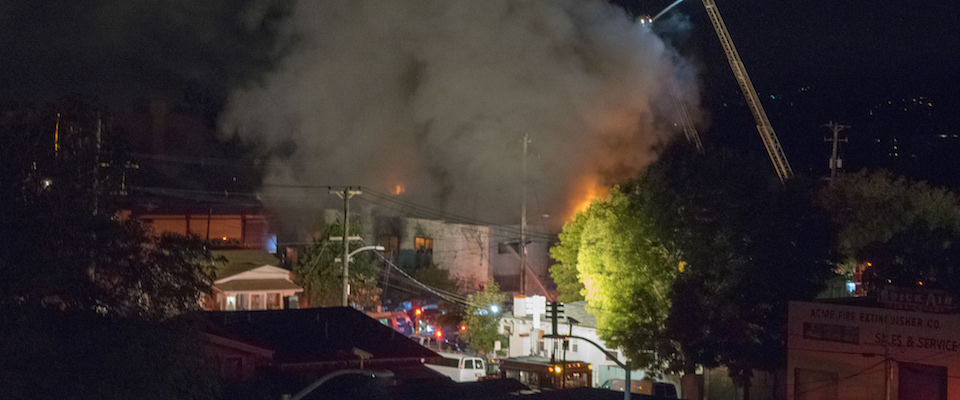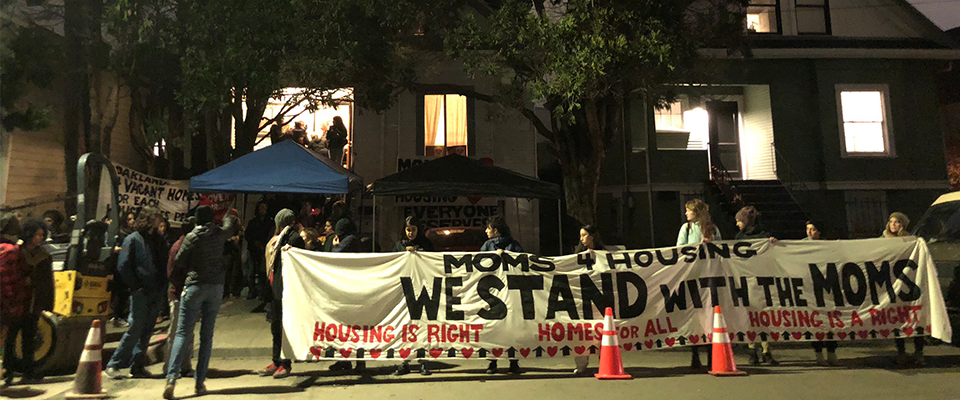Andrea Broaddus considers herself pretty lucky—she and her husband recently closed on a Berkeley duplex next to BART. “We leveraged ourselves to the hilt, but we managed to do it,” says Broaddus, a lecturer in regional and city planning at Cal’s College of Environmental Design. Still, it was nip-and-tuck to the end. The couple were shocked when they began looking for a house, and not simply by the prices.
They found the Bay Area’s real estate market positively Darwinian in its intensity, with buyers, sellers and real estate agents tearing at the limited housing stock and each other like famished predators.
“The first thing we found was that the asking price was just a ‘suggestion,’” says Broaddus. “Everything was bid up from there, often to 20 percent or more of the asking price. And everything was so frenzied. Bids were accepted, and then the buyers would walk away for one reason or another. We lost out on three places, and then we were accepted as the third-highest bid when the deals fell through with the other two buyers.” Even then, says Broaddus, she and her husband took the duplex without contingencies. “Our realtor strongly encouraged us to waive everything—no inspections—and we did,” she says. “The bottom line is that the place is going to take a lot of work. We’re basically gutting it.”
A friend of hers accepted her landlord’s $60,000 offer to vacate a rent-controlled apartment in San Francisco after having lived their eight years. Even so, “she was really attached to her apartment, her neighborhood, and San Francisco,” Broaddus says. “So she’s staying on for an extra year, paying triple her previous rent. But she knows she’ll have to leave. She just can’t afford it.”
Nor can most other people. That’s not exactly breaking news. Unless you bought your abode 20 years ago or are a member of the bucks-up technoscenti, you’re feeling the pain. Depending on the neighborhood, housing costs in San Francisco increased by 60 to 70 percent between 2012 and the end of 2015. Appreciation rates are comparable in the eight other Bay Area counties. According to research on urban displacement conducted by UC Berkeley professor of city and regional planning Karen Chapple, 48 percent of the neighborhoods in cities surrounding San Francisco Bay were facing intense resident displacement and gentrification pressures by 2013. It’s a trend, Chapple concludes, that will only accelerate.
Almost half of neighborhoods around San Francisco Bay have been displacing their own residents at “intense” rates—and estimates are it’s going to get a whole lot worse.
Looking down the road, the number of neighborhoods at risk of “displacement” is 123 percent greater than those areas now experiencing such pressures, Chapple calculates. Further, the phenomenon applies to all housing stock, from modest apartments and cottages in the Oakland flatlands and Hunter’s Point to the rambling, charming old homes in the bosky Berkeley Hills to the Lucullan mansions of Seacliff. Rent or buy, if you have to ask, you probably can’t afford it.
“There have been 500,000 new jobs created in the Bay Area since the recession ended,” says Carol Galante, professor of affordable housing and urban policy at Cal, “but only 50,000 new housing units have been built. That imbalance peaked in 2013 and has since tempered a bit, probably because some additional [housing] supply has come to market and the tech boom has moderated. But we’ve still seen double-digit rent increases in San Francisco and the East Bay year-over-year since 2013. And in general, coastal California is decades behind providing enough new housing stock to accommodate population growth.”
The obvious solution to the problem is to build a lot more housing. That, of course, is easier proposed then done, particularly in a highly regulated state like California. Developers have to jump through a lot of hoops to get a project approved. That takes time.
“And in the real estate business, time is most definitely money,” observes Elizabeth Deakin, a UC Berkeley professor emeritus of city and regional planning and urban design. “Construction is extremely cyclic. If you’re a builder, you usually have a window of opportunity—and sometimes a very narrow window—when you can build and sell.”
Specifically, all the economic and regulatory stars must converge before a developer can take the plunge and start putting up apartments, duplexes or single-family homes. Loans must be available at reasonable interest rates; the market must be sufficiently brisk so that what is built can be sold with alacrity; government agencies must be accommodating, or at least not aggressively obstructive.
“As it stands, every government jurisdiction makes proposed projects go through so many reviews that the costs in dollar outlay and time delays can be prohibitive,” says Deakin.
On top of that, many Bay Area cities are disinclined to approve new developments despite the plaintive declarations from public officials that something simply must be done. That’s partly due to the NIMBY phenomenon, Galante allows. People who already own or rent in a given area are often unenthusiastic about sharing their good fortune; new housing represents change, and people seldom embrace change, says Galante, particularly if it involves their neighborhoods.
Environmental concerns are also an issue, especially in the Bay Area. New housing raises the specter of increased traffic congestion and air pollution.
Too, says Jennifer Wolch, a Cal professor of city and regional planning, a great deal of affordable housing is lost due to “vacancy decontrol”—rental units going offline then re-emerging as much pricier abodes due to landlords jettisoning tenants either through settlements or pressure. Also, demolition of low-rent units is occurring in some areas to make way for other developments—either high-priced housing or retail and commercial projects.
 “Also, though there are state and federal directives to [municipal] jurisdictions to provide affordable housing, not enough is done to enforce them,” Wolch says. “There are no real penalties if targets are not met.”
“Also, though there are state and federal directives to [municipal] jurisdictions to provide affordable housing, not enough is done to enforce them,” Wolch says. “There are no real penalties if targets are not met.”
Then there’s Proposition 13, the 1978 voter-approved initiative that reduced and capped California property taxes. From a city manager’s point of view, Prop 13 is a disincentive for approving new housing.
“That’s why you see so many auto outlets and shopping malls,” says Deakin. “The sales taxes returned to municipalities from those projects are much greater than property taxes generated by new housing.”
Foreign investment is also a factor, says Malo Hutson, a Cal associate professor of city and regional planning.
“It’s not just the Bay Area,” says Hutson. “Markets like Los Angeles and New York are also seeing a huge jump in international investment. Wealthy people from Asia, western and eastern Europe and South America are looking for safe havens for their money, and choice American real estate looks good to them. They’re buying houses at an accelerating rate, and they’re paying cash. It’s distorting the entire housing market.”
And even if Proposition 13 were reformed to encourage more housing, Hutson says, many cities would still be loath to approve new developments. It’s not just that commercial development provides a more reliable tax base. Homes require a lot of expensive physical and social infrastructure: roads, schools, support services. With a car dealership, money just pours into city coffers. With new housing, some money goes in, but a lot goes out.
So what to do? Deakin thinks revisiting Proposition 13 is a pretty good place to start. The millions of homeowners who benefit from the initiative will resist anything that could increase their taxes, of course, and their clout is sufficient to make legislators balk at including them in any reform measure. But corporate property is also covered by Proposition 13; and while corporate influence remains strong in California, big business and big banks also are facing deep resentment from the hoi polloi, so lawmakers could be sufficiently emboldened to jack up the property taxes on corporate real estate holdings.
“PG&E, for example, owns vast amounts of land, and they never sell it, so their property taxes have remained low,” says Deakin. “If rates on corporate properties were raised it could generate a lot of revenue that cities could dedicate to affordable housing.”
Another partial remedy could be tax-sharing, says Deakin: A portion of state sales taxes could be distributed to various cities for affordable units.
 Indeed, some progress is being made. Gov. Jerry Brown has promoted legislation that would expedite housing construction by slashing the red tape that encumbers most new projects. Under the plan, developments that meet specific criteria for affordable housing would be exempted from most local reviews. The proposal could have significant consequences for the Bay Area, where wealthy communities have been able to put the kibosh on developments by subjecting them to unending evaluation.
Indeed, some progress is being made. Gov. Jerry Brown has promoted legislation that would expedite housing construction by slashing the red tape that encumbers most new projects. Under the plan, developments that meet specific criteria for affordable housing would be exempted from most local reviews. The proposal could have significant consequences for the Bay Area, where wealthy communities have been able to put the kibosh on developments by subjecting them to unending evaluation.
And just last week, San Francisco voters passed Measure C, which will more than double the stipulated affordable housing quota for new developments. Paradoxically, though, the measure could result in effects opposite of those desired. Some analysts claim it will ultimately result in less housing stock, because the new requirements mean San Francisco housing projects won’t pencil out for developers; the profits will be inadequate. New projects won’t be proposed.
Some cities are considering other fixes, such as loosening strictures on in-law and au pair units. In any event, new developments—affordable or not—often meet resistance not just from wealthy homeowners who want to protect property values, but from progressive activists as well. That’s because development often translates as environmental impacts: loss of open space, increased traffic congestion, dewatered creeks and polluted air. But it doesn’t have to be that way, says Galante.
“We don’t have to sprawl outward,” says Galante. “There’s plenty of land in the Bay Area—particularly in places like Alameda and Silicon Valley—where we can infill open lots that are close to transit hubs. In fact, that’s the only practical solution. We want to discourage people from moving out to places like Lodi or Tracy, because that does eat up open space and agricultural land and increases commuter congestion.”
Deakin agrees. Younger urbanites are far less obsessed with parking space than earlier generations, she says, and this trend likely will continue. If housing is built near transportation and retail outlets, she maintains, the people will come, and they are unlikely to bring their cars with them. “People may be totally freaked out about [lack of] parking space in the beginning, but they usually discover that it’s a major pain to own a car in the city,” she says.
 Recently she sent some of her students to survey residents of Berkeley apartments built by Patrick Kennedy, a developer noted for his “micro-unit” projects, many of which are built near mass-transit hubs. Most of the people surveyed were not stressed by the lack of parking for a simple reason: They didn’t own cars. When they needed a vehicle, they used a ride-sharing service or rented a car. Mostly, they used BART to get around.
Recently she sent some of her students to survey residents of Berkeley apartments built by Patrick Kennedy, a developer noted for his “micro-unit” projects, many of which are built near mass-transit hubs. Most of the people surveyed were not stressed by the lack of parking for a simple reason: They didn’t own cars. When they needed a vehicle, they used a ride-sharing service or rented a car. Mostly, they used BART to get around.
“The bottom line is that the rate of car ownership was low among the residents,” says Deakin. “They found that cars were too expensive to maintain and park, and many said parking was also an issue at their work places. They didn’t want them.”
Still, infilling areas near BART stations is hardly a panacea, says Hutson. That’s because new units conveniently located near mass transit and shopping are highly desirable, and hence expensive. Not enough of the apartments are covered by so-called inclusionary housing programs that mandate lower-income units.
“And in the Bay Area, let’s face it, a family earning $75,000 a year is lower income,” says Hutson. “You’re just scraping by. The fact is that people are moving farther out, and commuting into the city, creating congestion, contributing to sprawl and straining infrastructure. And piecemeal solutions aren’t going to turn that around.”
Ultimately, says Hutson, the current situation—or any likely permutation of it—is unsustainable.
“We’re already seeing the cracks,” he says. “I know a lot of restaurateurs, and they tell me they can’t keep employees because nobody can afford to live [in the area] for $15 an hour. It’s getting harder for Cal to attract young faculty members because they can’t afford to live here. The sticker shock hits them hard. Why should they move to Berkeley when they can teach at, say, the University of Michigan, where they can afford a nice house, and live very well? I know young faculty members living in tiny in-law units here. It’s coming down to our core values, to the kind of cities we want. Are they only for the elite, or do we value young families, teachers, artists, young engineers and entrepreneurs just starting out? If we don’t want our cities to become exclusive enclaves for the very rich, we have to be willing to make major and effective changes.”
Note: Everybody may have an opinion on housing, but getting the facts and identifying possible solutions is tough. Toward that end, Berkeley’s Terner Center for Housing Innovation has developed the Housing Development Dashboard: an open-source interactive platform that collects the various factors that could affect a project—parking ratios, land costs, zoning, market conditions, available financing among them—and applies them to specific Bay Area cities on a parcel-by-parcel basis, and provides a prediction on the likelihood of a given project getting built.
“It lets people see how various policies can affect development costs, and it lets policy makers and developers see which factors are most problematic for a specific development in a specific area,” says Carol Galante. “We made a generic tool for general analysis, and then we went deep for Oakland, Pleasanton, San Francisco and Menlo Park. For those four cities, we created a gauge that analyzes the impact policy changes could have on housing construction across an entire jurisdiction. We hope to develop specific policy gauges for other cities soon.”




















